View in other NatureServe Network Field Guides
NatureServe
Montana
Utah
Wyoming
Idaho
Wisconsin
British Columbia
South Carolina
Yukon
California
New York
Yellow Fine-Leafed Tomentypnum Moss - Tomentypnum nitens
Other Names:
Wooly Feather Moss,
Homalothecium nitens
General Description
Plant: Pleurocarpous (Vitt 1988). Erect and tufted or scattered with other mosses. Glossy, yellow-green to brown below; sometimes with green tips. Stems 5-15 cm tall, branching irregularly. Rhizoids often clustered and can arise from the base of leaves or back of costa.
Leaf: Leaves erect to erect-spreading, elongate-lanceolate (rarely slightly falcate), deeply plicate. Stem leaves 3-4 x 0.7-0.9 mm and branch leaves smaller. Apex gradually acuminate to long and narrow. Margins entire to nearly entire. Costa ends before the apex, 3/4 to 4/5 the length of leaf, and has no spines.
Leaf Cells: A few rows of basal cells are shorter, wider, and more pitted than the median cells. Median leaf cells are 50-90 x 5-6 µm, thick-walled, long, and narrow. Alar cells are like the basal cells and do not form a distinct group.
Phenology
Capsules ripen early to mid summer (FNA 2014).
Range Comments
Greenland; St. Pierre and Miquelon; Canada: AB, BC, MB, NB, NL, NT, NS, NU, ON, QC, SK, YT; USA: AK, CA, CO, CT, ID, IL, ME, MA, MI, MN, MT, NH, NJ, NM, NY, ND, OH, OR, PA, UT, VT, WA, WV, WI, WY; n, c Europe; n Asia; Atlantic Islands (Iceland) (FNA 2014). In Montana, known from Carbon, Deer Lodge, Flathead, Gallatin, Glacier, Lake, Lewis and Clark, Lincoln, Sanders, and Stillwater Counties (Elliott 2016).
Observations in Montana Natural Heritage Program Database
Number of Observations: 47
(Click on the following maps and charts to see full sized version)
Map Help and Descriptions
Relative Density
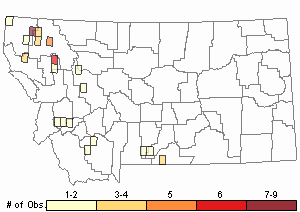
Recency
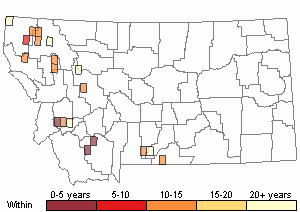
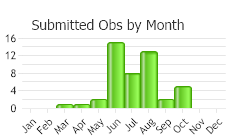
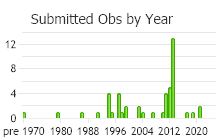
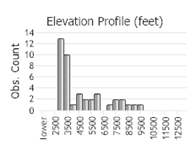 (Observations spanning multiple months or years are excluded from time charts)
(Observations spanning multiple months or years are excluded from time charts)
Habitat
Damp soil and humus in fens (Elliott 2016), bogs, wetlands, and other wet places. Usually in the mountains, up to 10,000 feet elevation.
Ecology
The plants grow upright, sometimes forming mounds in fens (Vitt 1988).
Reproductive Characteristics
Dioicous, often sterile. Seta is 2.0-5.0 cm tall and smooth. Capsules short and thick, zygomorphic, 2-3 mm long, and contracted under the mouth when dry (FNA 2014).
References
- Literature Cited AboveLegend:
 View Online Publication
View Online Publication Elliott, J.C. and A.K. Pipp. 2018. A Checklist of Montana Mosses (1880-2018). Updated 3 January, 2020. Montana Natural Heritage Program, Helena, Montana. 73 pp.
Elliott, J.C. and A.K. Pipp. 2018. A Checklist of Montana Mosses (1880-2018). Updated 3 January, 2020. Montana Natural Heritage Program, Helena, Montana. 73 pp. Flora of North America Editorial Committee, eds. 2014. Flora of North America North of Mexico. Volume 28. Bryophytes: Mosses, Part 2. Oxford University Press, Inc., NY. xxi + 702 pp.
Flora of North America Editorial Committee, eds. 2014. Flora of North America North of Mexico. Volume 28. Bryophytes: Mosses, Part 2. Oxford University Press, Inc., NY. xxi + 702 pp. Vitt, D. J. Marsh, and R. Bovey. 1988. Mosses, Lichens & Ferns of Northwest North America. Seattle, WA: University of Washington Press. 296 p.
Vitt, D. J. Marsh, and R. Bovey. 1988. Mosses, Lichens & Ferns of Northwest North America. Seattle, WA: University of Washington Press. 296 p.
- Additional ReferencesLegend:
 View Online Publication
View Online Publication
Do you know of a citation we're missing? Elliot, J. C. 1993. Second checklist of Montana mosses. Unpublished report. U.S. Forest Service, Region 1. Missoula, MT. 45 pp.
Elliot, J. C. 1993. Second checklist of Montana mosses. Unpublished report. U.S. Forest Service, Region 1. Missoula, MT. 45 pp. Lawton, E. 1971. Keys for the Identification of the Mosses on the Pacific Northwest. Reprinted from 'Moss Flora of the Pacific Northwest'. Published as Supplement No. 2 of the Journal of the Hattori Botanical Laboratory. Nichinan, Miyazaki, Japan. 66 pp.
Lawton, E. 1971. Keys for the Identification of the Mosses on the Pacific Northwest. Reprinted from 'Moss Flora of the Pacific Northwest'. Published as Supplement No. 2 of the Journal of the Hattori Botanical Laboratory. Nichinan, Miyazaki, Japan. 66 pp. Lawton, E. 1971. Moss Flora of the Pacific Northwest. Hattori Botanical Laboratory. Japan: Yamabuki-cho, Shinjuku-ku, Tokyo. 362 pages plus appendices.
Lawton, E. 1971. Moss Flora of the Pacific Northwest. Hattori Botanical Laboratory. Japan: Yamabuki-cho, Shinjuku-ku, Tokyo. 362 pages plus appendices.
- Web Search Engines for Articles on "Yellow Fine-Leafed Tomentypnum Moss"





